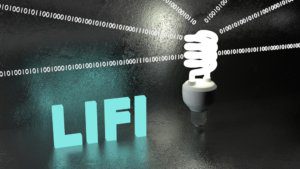Wireless
Wireless RF Spectrum Scarcity, What About Light Wave?

The scarcity of unlicensed RF spectrum is a never-ending subject in the wireless industry. The 2.4 and 5 GHz bands, once considered profuse, are now overcrowded and regulators such as the FCC are planning to release 1.2 GHz of bandwidth in the 6 GHz band. Over the last decade, this has fueled a growing interest in Light Communication (LC) technologies that offer the potential of THz of unlicensed spectrum including visible light, near-infrared and near-UV. Standard LEDs are now providing illumination while transmitting data at a high rate, and laser diodes (LDs) can reach ~100 Gbps in point to point communications. The recent introduction of products on the market for internet access and wireless backhauling show that the technology is becoming a reality.
What Is Light Communication?
In light communications, the signal is transmitted by an emitting diode (LED/LD) using Intensity Modulation, where the brightness of the light is modulated at a high frequency, imperceptible to the human eye. At the receiver, a photodiode or a camera image sensor converts the received optical power to an electrical signal using Direct Detection. Dimming is possible but often impacts the performance of the system. Rates of Multi-Gbps have been demonstrated with standard phosphor-coated LEDs (1 Gbps) or RGB LEDs (3 Gbps), using advanced modulation technics such as OFDM. Laser Diodes achieves higher data rate over much longer distances but are not always practical in consumer application due to potential health issue and the quality of laser light for illuminations.
LC offers the advantages of a large, unregulated, license-free spectrum, and is already capable in lab environment of reaching 100 Gbps (near field communication). The technology is particularly adapted to environments where RF communications are restricted or pose health concerns. LC is also considered as more “secure” against hackers since the communication is confined in the cone of light within a well-defined coverage zone. Line of Sight (LOS) is required for most use cases.
LC Applications: From Specialized to Mass Markets
With the technology being quite recent, different industries including lighting, transportation, industrial/manufacturing and telecommunication are evaluating its potential.
Specialized markets include location-based services where illuminations can provide a precise location. “Light beacons” are received by smartphone’s camera (supported by recent cell phone models) and an App provides services to enhanced user experience in retail stores or museum places. The aerospace industry is also considering LC to deliver in-flight entertainment.
Outdoor terrestrial link scenarios are attracting much interest fueled by the need of cost-effective wireless backhauls, especially in the context of 5G (small cells). The laser diode transmission usually operates on the near-infrared spectrum due to lower attenuation levels. The technology is part of the Free Space Optic (FSO) communication family that requires a strict line of sight. Available solutions reach 1 Gbps over up to 300 meters with a good reliability, and speeds up to 10 Gbps are on roadmaps. Over longer distances, however, bad weather conditions, especially fog and dust, can significantly affect the throughput. For this reason, the technology is often complemented with mmWave which is mostly affected by rain.
The mass market opportunity, however, resides in the Wireless Local Area Network (WLAN) applications where the technology, referred as Light Fidelity (Li-Fi), can complement or, in some cases, replace Wi-Fi. IEEE 802 has recently added a Light Communication task group (802.11bb) to complement the 802.11 family, recognizing the potential of Li-Fi. The standard specifies a PHY operating in the in 380 nm to 5,000 nm band (visible light, near-infrared, near-UV) targeting data rate from 10 Mbps up to at least 5 Gbps for a single link throughput. The uplink in Li-fi systems is usually based on IR transmission due to power limitation of the mobile devices and potential glare of visible light to the user.
Environments that restrict the use of EMI (Electromagnetic Interference) such as hospital, schools and factories are likely to fuel the industry in the next 5 years. The office/enterprise environment is also well suited for Li-Fi where lighting is ubiquitous and Power Over Ethernet is available and serves as a backhaul. In residential environments, Li-Fi can locally offload traffic in heavily populated apartments where RF interference is the primary concern. All these applications are addressed by the 802.11bb standard, while ITU G.vlc focuses on the residential environment.

Light communication is a promising technology that is still in its infancy. The growing interest in this technology is driven by the availability of a huge unlicensed spectrum not susceptible to RF interferences. As CableLabs continues to focus on developing new and innovative wireless technologies, light communications will definitively stay on the radar.
To stay current with what CableLabs is doing in the wireless space, make sure to subscribe to our blog.


